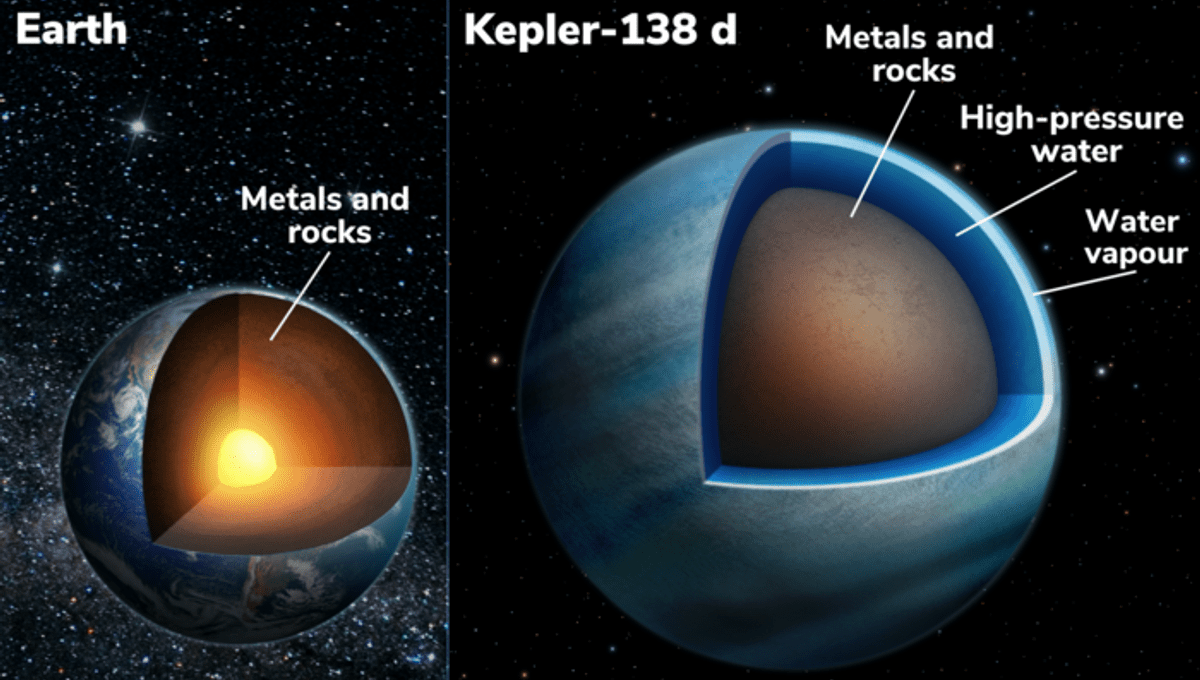
All life on Earth depends on liquid water, and astrobiologists think that may be universal. That makes the discovery of water on other planets a priority, and two new discoveries are thought to have it in an abundance that makes the Earth look dry. Lurking in the same system is a suspected planet that could be more interesting still.
Science fiction writers often talk of “water worlds” but the term can mean different things. For some people, a water world is something like the Earth when life was first evolving, with no large continents, just small islands poking above the oceans.
There’s another type of water world, however, one that has more water than rock and metal combined, and this is what University of Montreal PhD student Caroline Piaulet thinks Kepler-138 c and d might be. Piaulet has yet to get a spectrum to confirm the presence of H2O, but in a new study, she and co-authors report densities for the two planets that are hard to explain any other way.
Kepler-138 (sometimes known as KOI-314) is one of the first stars where the Kepler Space Telescope recorded regular dips in brightness indicative of multiple planets passing across the face. It’s a red dwarf only about a 40th as luminous as the Sun.
The innermost of the known worlds, Kepler-138b, is about the mass of Mars, but far too hot for biological interest. Kepler-138c and d are also uncomfortably hot, thought to average 80°C and 140°C (176-284°F), respectively. The second and third planets are both about 50 percent wider than the Earth.
Initial estimates of their mass suggested Kepler-138c is almost as dense as the Earth, and therefore mostly rock. Kepler-138d was thought to be substantially less dense, making it a candidate to be a water world.
However, Piaulet and her supervisor Professor Björn Benneke dispute the previous mass estimates for Kepler 138-b, claiming both have densities two-thirds of Earth’s.
“Imagine larger versions of Europa or Enceladus, the water-rich moons orbiting Jupiter and Saturn, but brought much closer to their star,” Piaulet said in a statement. Too close, in fact, to harbor ice. Indeed, their temperatures, particularly Kepler-138c’s, are probably above the boiling point of water. That means steam atmospheres, possibly with oceans kept liquid by the intense pressure despite the high temperatures, or a more exotic phase of water known as a supercritical fluid.
In August, Montreal researchers reported a planet they think is 30 percent water, but the density estimates suggest Piaulet’s pair go further, having more water than anything else.
“It is the first time we observe planets that can be confidently identified as water worlds, a type of planet that was theorized by astronomers to exist for a long time,” Benneke said.
The size of transiting planets can be calculated from the amount the starlight dips as they pass in front. Mass is usually estimated based on the movements the planets induce in the star. However, in multi-planetary systems, it’s possible to look at the effect each planet has on the orbit of the others to find their gravity, and therefore mass. Piaulet and Benneke used this to produce more precise masses for Kepler-138c and d.
In the process of their research, the pair found variations in the transit times indicative of the tug of a fourth planet. However, the putative Kepler-138e does not transit, so we can’t know its size or composition. However, if it’s real, its orbital distance suggests a temperature modestly higher than Earth’s. If Kepler-138e is also a water world, the system could really be exciting.
The paper is published in Nature Astronomy.
Source Link: Two Exoplanets Appear To Be Mostly Water, Some Of It Possibly Liquid